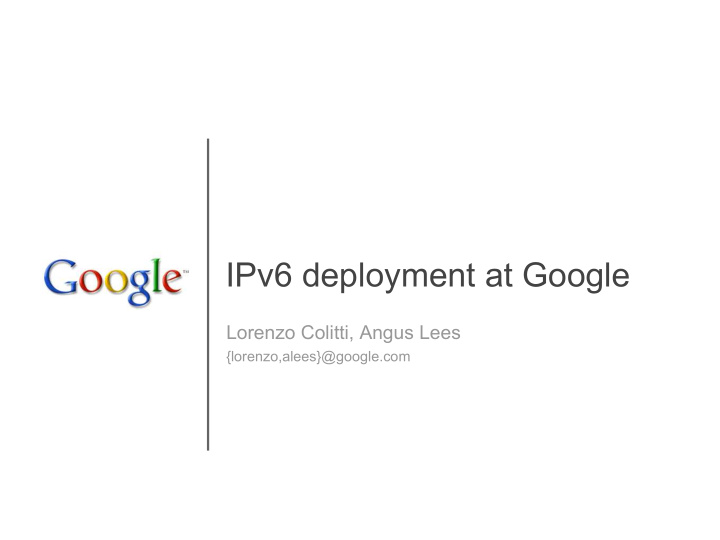



IPv6 deployment at Google Lorenzo Colitti, Angus Lees {lorenzo,alees}@google.com
Why? Lorenzo Colitti, Angus Lees IETF 72 Dublin, July 2008
Why IPv6? When the day comes that users only have IPv6, Google needs to be there If we can serve our users better over IPv6, then we will IPv6 can have lower latency and packet loss ... and we have user reports to prove it AJAX applications break behind excessive NAT Too many connections exhaust public IP port space NAT traversal complicates apps like Google Talk Developer time better spent elsewhere Lorenzo Colitti, Angus Lees IETF 72 Dublin, July 2008
The reasoning is simple IPv6 is going to happen RIR pool exhaustion Dec 2011 IPv6 the only solution that really makes sense Not a question of if, but when We might as well start now Early adoption critical for service quality in the future Act now to save money later It's not rocket science, but it takes time! Lorenzo Colitti, Angus Lees IETF 72 Dublin, July 2008
IPv6 is Not Rocket Science™ Lorenzo Colitti, Angus Lees IETF 72 Dublin, July 2008
What worked for us IPv6 at Google started as a 20% project Like gmail and news :-) Built a pilot network Lab testing, engineering, pilot deployment Proved architecture at internal IPv6 conference Once network was up, applications followed Scaled up architecture, productionized Monitoring, documentation, support, ... Lorenzo Colitti, Angus Lees IETF 72 Dublin, July 2008
You can do it too Tap enthusiasm 20% project had incredible influx of contributors Make it easy for contributors to get initial results A pilot network is not expensive Once network is up, internal applications will follow Do it in stages v6 doesn't have to be as capable as v4 on day one! Make slow, steady progress: operators are cautious Remember: it's not rocket science. It just takes time Lorenzo Colitti, Angus Lees IETF 72 Dublin, July 2008
Lessons Learned Lorenzo Colitti, Angus Lees IETF 72 Dublin, July 2008
Operations: be consistent Dispel notion that IPv6 is "experimental" IPv6 must be a production service Monitored Supported Designed to the same quality standards as IPv4 How to achieve this? Make NOC aware of IPv6 Scale down, but don't skimp Design as closely to IPv4 as possible Make the principle of least surprise work for you Lorenzo Colitti, Angus Lees IETF 72 Dublin, July 2008
Device support: adequate Feature parity not there yet No MPLS TE for IPv6 No extension header filtering in hardware NAT-PT temperamental No 6to4/Teredo in hardware Load-balancing not mature yet Reliability not quite ironed out Load balancer memory leaks Router crashes (fixed on same day) None of these are showstoppers But might want to start with dedicated devices :-) Lorenzo Colitti, Angus Lees IETF 72 Dublin, July 2008
Internetworking: patchy Tunnels increase latency and complicate debugging Avoid them, especially for interdomain traffic! IPv6 interdomain routing patchy Indiscriminate transit Slows convergence, increases RTT Blackholing, incomplete visibility, ... Peering, peering, peering Quality of deployed IPv6 highly variable Interconnecting production-ready networks creates production-ready Internet Lorenzo Colitti, Angus Lees IETF 72 Dublin, July 2008
The real challenge How do we adopt IPv6 while maintaining Google quality of service? www.google.com IN AAAA not the solution today Lower reliability and higher latency for many users Partial/total breakage for small percentage of users Our users rely on us Breakage is unacceptable! Bad IPv6 worse than no IPv6 (timeouts, ...) Bilateral relationships the way forward? Directly connect IPv6 clients to IPv6 content Lorenzo Colitti, Angus Lees IETF 72 Dublin, July 2008
The way forward? Lorenzo Colitti, Angus Lees IETF 72 Dublin, July 2008
IPv6-only networks with NAT-PT Client goes IPv6-only to ease address exhaustion NAT-PT provides connectivity to IPv4 content Solves chicken and egg problem Clients can move to v6 without waiting for content When other end gets v6, NAT goes away Transforms the content deployment problem into an application porting problem More and more applications run inside the browser Enterprises might only need a few applications You might not need v4 on the client at all! Lorenzo Colitti, Angus Lees IETF 72 Dublin, July 2008
Undeprecate RFC 2766? NAT-PT is deprecated by RFC 4966 All the drawbacks in 4966 are present in v4 NAT too But this is how the IPv4 Internet works today We need a bare-bones NAT-PT standard The standard should not require host support It's a little late to change host stacks now NAT breaks end-to-end. But: Better IPv6 end-to-end+NAT-PT than just IPv4 NAT Post IPv4 runout, new hosts will be NATed anyway Lorenzo Colitti, Angus Lees IETF 72 Dublin, July 2008
IPv4-style multihoming Multiple-address multihoming doesn't work Failover breaks TCP connections HIP/SHIM6 not equivalent to IPv4-style multihoming Failover works, but new connections see timeouts No load-balancing or traffic engineering Doesn't sound convincing for mission-critical applications IPv6 deployment must not block on IPv6 multihoming! /48 needs to be accepted in DFZ Lorenzo Colitti, Angus Lees IETF 72 Dublin, July 2008
Deployment-friendly licensing Some vendors require software licenses for IPv6 Price is trivial, but paperwork and approvals are a barrier to entry Turning a lab into a real deployment will require hardware upgrades anyway Spending $500k in licenses to roll out IPv6 in a large network all at once likely to be hard sell Charging extra for IPv6 support will hinder adoption OS manufacturers don't charge extra for IPv6... Lorenzo Colitti, Angus Lees IETF 72 Dublin, July 2008
How can the IETF help? Bare-bones NAT-PT for IPv6-only networks No change in host stacks Minimalistic, simple to standardize / implement Allow /127s on point-to-point links Currently forbidden by RFC 4291 Finalize VRRP for IPv6 Current NUD not fast enough for production failover Last VRRP draft Feb 2006 Allow multihoming using /48 prefixes Lorenzo Colitti, Angus Lees IETF 72 Dublin, July 2008
Questions? Lorenzo Colitti, Angus Lees {lorenzo,alees}@google.com
Recommend
More recommend